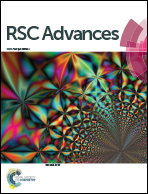Flexible supercapacitors based on 3D conductive network electrodes of poly(3,4-ethylenedioxythiophene)/non-woven fabric composites
Abstract
We design a flexible supercapacitor with poly(3,4-ethylenedioxythiophene) nanowire-coated non-woven fabrics (PEDOT/NW) as the electrode material via a simple and low-cost chemical polymerization synthesis. PEDOT nanowires depositing on non-woven fabrics form a conductively and mechanically robust composite that is utilized directly as an electrode without introducing organic binders or conducting additives. The PEDOT/NW electrodes are characterized by scanning electron microscopy (SEM) that confirms the porous morphology of PEDOT/NW at the nanoscale. The capacitive characteristics of the supercapacitor are evaluated by cyclic voltammetry, galvanostatic charge–discharge and electrochemical impedance spectroscopy techniques. The PEDOT/NW composites afford a high-efficient and stable electrode for a supercapacitor showing high specific capacitance of 169 F g−1 and excellent energy density of 21.1 W h kg−1 as well as good long-term cycling stability with 90% specific capacitance retained after 1000 cycles. Therefore, this conductively porous PEDOT/NW electrode holds considerable promise as a flexible, low-cost and high-efficient electrode material.


 Please wait while we load your content...
Please wait while we load your content...